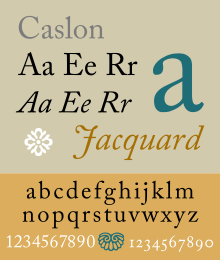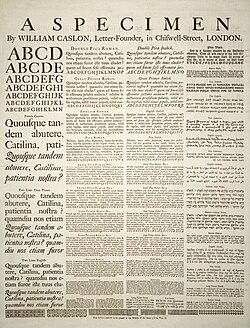Caslon
 | |
| Category | Serif |
|---|---|
| Classification | Transitional[1] |
| Designer(s) | William Caslon I |
| Foundry | Caslon Type Foundry |
| Variations | Adobe Caslon Big Caslon LTC Caslon Founders Caslon ITC Founders Caslon Wyld Caslon 3 Caslon 224 Caslon 471 Caslon 540 Caslon 641 Caslon Old Face |
| Shown here | Adobe Caslon by Carol Twombly |



Caslon refers to a number of serif typefaces designed by William Caslon I (1692–1766), and various revivals thereof.
Caslon shares the irregularity characteristic of Dutch Baroque types. It is characterized by short ascenders and descenders, bracketed serifs, moderately-high contrast, robust texture, and moderate modulation of stroke. The A has a concave hollow at the apex, the G is without a spur. Caslon's italics have a rhythmic calligraphic stoke. Characters A, V, and W have an acute slant. The lowercase italic p, q, v, w, and z all have a suggestion of a swash.
History
Caslon's earliest design dates to 1722[2]. Caslon is cited as the first original typeface of English origin, but some type historians point out the close similarity of Caslon's design to the Dutch Fell types.
The Caslon types were distributed throughout the British Empire, including British North America. Much of the decayed appearance of early American printing is thought to be due to oxidation caused by long exposure to seawater during transport from England to the Americas. Caslon's types were immediately successful and used in many historic documents, including the U.S. Declaration of Independence. After William Caslon I’s death, the use of his types diminished, but saw a revival between 1840–80 as a part of the British Arts and Crafts movement. The Caslon design is still widely used today. For many years a common rule of thumb of printers and typesetters was When in doubt, use Caslon.[3]
Several revivals of Caslon do not include a bold weight. This is because it was unusual practice to use bold weights in typesetting during the 18th century, and Caslon never designed one. For emphasis, italics or a larger point size, and sometimes caps and small caps would be used instead.
Revivals
With the rise of hot metal typesetting beginning at the close of the 19th century, existing foundry metal typefaces such as Caslon's had to be adapted to specific typesetting technology. This was true again with phototypesetting, mostly in the 1960s and 1970s, and then again with digital typesetting technology, mostly since the mid 1980s. As a result of that, and the lack of trademark on the name "Caslon" by itself, there are many typefaces called "Caslon" with some other distinguishing element, which reproduce the original designs in varying degrees of faithfulness.
Variations
Adobe Caslon (1990)
Adobe Caslon is a variant designed by Carol Twombly and based on the Caslon's own specimen pages printed between 1734 and 1770.[4] Small caps, old style figures, swash letters, ligatures, alternate letters, fractions, subscripts and superscripts, and ornaments were included with the Adobe Caslon Expert family.[5]
Adobe Caslon Pro incorporates the previous expert letters, adds ordinals, arbitrary fractions, and extends the language coverage to include central European languages.[2]
Caslon Old Face
Caslon Old Face nowadays is a generic term used to describe a typeface that appears to be true to those designed by William Caslon himself. Originally it referred to the Caslon matrices and type which were property of the H.W. Caslon & Sons foundry. In 1937 the H.W. Caslon & Sons foundry was acquired by Stephenson Blake & Co who thereafter added 'the Caslon Letter Foundry' to their name.
George Ostrochulski adapted the designs from Stephenson Blake & Co for photocomposition at Mergenthaler Linotype with skill and understanding during the 1950s.
A variety of typefaces called Caslon Old Face are available commercially. Visual differences exist between typefaces from different companies and the authenticity of some of these typefaces is debatable.
Caslon 471
Caslon 471 was designed by the staff of American Type Founders as their first revival of Caslon. It is based on the Old Style No. 1 typeface used in an 1865 specimen book from the L.J. Johnson foundry in Philadelphia.
Caslon 540
Caslon 540 was designed by the staff of American Type Founders and released in 1902. The typeface was originally intended for use in advertising and is based on Caslon 471 with shortened descenders. It does not include a bold weight.
Caslon 3
A slighter bolder version of Caslon 540, released by American Type Founders in 1905. BitStream sells Caslon 3 under the name of Caslon Bold.
Caslon 641
A heavy version of Caslon 540, released by American Type Founders in 1966.
Caslon 224
Caslon 224 was designed by Ed Benguiat of ITC, and released in 1983. The result of his efforts is a highly-readable typeface, featuring a large x-height, smooth weight transitions, and careful structuring of hairline strokes, offered in four weights (book, medium, bold, and black) each with a matching italic.
In lectures, Benguiat has frequently said he chose the number 224 because it was the address of the building where he did most of his work.
Big Caslon
Big Caslon is a revival based on the three largest sizes of type from the H.W. Caslon & Sons foundry by Matthew Carter of Carter & Cone in 1994. The typeface is intended for use at eighteen point and above.[citation needed]. It is bundled with Apple's OS X operating system.
Caslon Openface
A decorative openface serif typeface with very high ascenders, designed by Barnhart Brothers and Spindler in 1915, that is only loosely based on the typefaces designed by William Caslon himself.
ITC Founder's Caslon (1998)
ITC Founder's Caslon was digitized by Justin Howes. He used the resources of the St. Bride Printing Library in London to thoroughly research William Caslon and his types.[6] Unlike previous digital revivals, this family closely follows the tradition of building separate typefaces intended for different sizes, despite the use of scalable typefaces in the digital counterpart.
This family was released by ITC in December 1998[7]. It includes separate fonts for 12 point, 30 point, 42 point, and Poster sizes, and a typeface for ornaments. Also following the original Caslon types, it does not include bold typefaces, but uses old style figures for all numbers.
Another feature in the Windows TrueType version of the typeface is the allocation of extra ligatures and alternate forms to Basic Latin and ISO Latin-1 blocks, replacing |, <, >, =.
The OpenType Std version of the typeface adds small caps to the family and updates the character set to support the Adobe Western 2 character set.
H. W. Caslon version
Following the release of ITC Founder's Caslon, Justin Howes revived the H.W. Caslon & Company name, and released an expanded version of the ITC typefaces under the Founders Caslon name.
Caslon Old Face is a typeface with multiple optical sizes, including 8, 10, 12, 14, 18, 22, 24, 30, 36, 42, 48, 60, 72, 96 points. Each font has small capitals, long esses and swash characters. The 96 point font came in roman only and without small capitals. Caslon Old Face was released in July 2001.
Caslon Ornaments is a typeface containing ornament glyphs.
These typefaces are packaged in the following formats:
- Founders Caslon 1776: Caslon Old Face (14), Caslon Ornaments.
- Founders Caslon Text: Caslon Old Face (8, 10, 12, 14, 18), Caslon Ornaments.
- Founders Caslon Display: Caslon Old Face (22, 24, 30, 36, 42, 48, 60, 72), Caslon Ornaments.
However, following the death of Justin Howes, the revived H.W. Caslon & Company went out of business, and the expanded Founders Caslon is no longer offered in the retail market.
LTC Caslon (2005)
LTC Caslon is a remastering of the Lanston Type Company's 14 point size of their revival of Lanston Monotype's Caslon 337 of 1915 (itself a revival of the original Caslon types) [8]. This family include fonts in 2 weights, complementary italics, and long descender typefaces The character sets are expanded to include fractions, ligatures, swashes (italics only), and Central European characters.[9]
LTC Caslon Remix
The LTC Caslon Remix typeface is a variant of LTC Caslon Pro found in the P22 Records music CD William Caslon Experience, an album by The William Caslon Experience (Nate Butler, Mart Schaefer) remixed by Odiorne.[10] The CD is included with the purchase of the LTC Caslon family.[11]
Wyld
A modern day recreation of Caslon by David Manthey which is intended to exactly match the typeface found in The Practical Surveyor, by Samuel Wyld[12], published in London in 1725. The typeface contains glyphs for several ligatures commonly used in printing during the early 18th century. It does not include a bold weight.
Williams Caslon Text
A modern attempt to capture the spirit of Caslon by William Berkson currently used in Boston magazine[13]. Although not aimed at being fully authentic in every respect, the typeface closely follows Caslon's original specimen sheet in many respects, including varied slopes for the italic letters. The weight is heavier, to compensate for changes in printing processes.
Franklin Caslon
This 2006 creation by P22 is based on the pages produced by Benjamin Franklin circa 1750. It has a distressed appearance.
Caslon Antique
This decorative serif typeface was originally called Fifteenth Century, but later renamed Caslon Antique. It is not generally considered to be a member of the Caslon family of typefaces, because its design appears unrelated, and the Caslon name was only applied retroactively.
See also
- Caslon Roman, a Unicode typeface (for computer), developed by George Williams.
- History of typography
References
- ^ According to [1], Adobe's webpage for its iteration of Caslon
- ^ a b Adobe Caslon Pro
- ^ http://www.itcfonts.com/Ulc/2532/Caslon.htm
- ^ Adobe Caslon
- ^ Adobe Caslon Expert
- ^ ITC Founder's Caslon Font Family - by Justin Howes
- ^ What's Hot From ITC: 1998
- ^ Caslon Oldstyle, No. 337
- ^ Caslon Pro
- ^ The William Caslon Experience
- ^ P22 - Audio
- ^ The Practical Surveyor, by Samuel Wyld
- ^ [2]
- Carter, Rob, Day, Ben, and Phillip Meggs. Typography Design: Form and Communication. John Willey & Sons, Inc.: 1993. ISBN 0-471-28430-0
- Friedl, Friedrich, Nicolaus Ott and Bernard Stein. Typography, An Encyclopedic Survey of Type Design and Techniques throughout History. Black Dog & Leventhal: 1998. ISBN 1-57912-023-7
- Lawson, Alexander S., Anatomy of a Typeface. Godine: 1990. ISBN 978-0879233334.
- Meggs, Phillip B, McKelvey, Roy. Revival of the Fittest: Digital Versions of Classic Typefaces. RC Publications, Inc.2000. ISBN 1-883915-08-2
- [4] Nesbitt, Alexander The History and Technique of Lettering (c) 1998, Dover Publications, Inc. ISBN 0486402819 , The Dover edition is an abridged and corrected republication of the work originally published in 1950 by Prentice-Hall, Inc. under the title Lettering: The History and Technique of Lettering as Design.
- Updike, Daniel Berkeley. Printing Types: Their History, Forms, and Use. Dover Publications, Inc.: 1980. ISBN 0-486-23929-2
External links
- Typowiki: Caslon
- Typowiki: Caslon Old Face
- U&lc Online Issue: 25.3.2: ITC Founder's Caslon
- What's Hot From ITC: August 2004
- H. W. Caslon and Company home page
- Microsoft Typography: H. W. Caslon & Company
- Justin Howes: Expert on letter forms, preserver of original typefaces and curator of the Type Museum in London
- Founder’s Caslon character sets
- Wyld typeface
